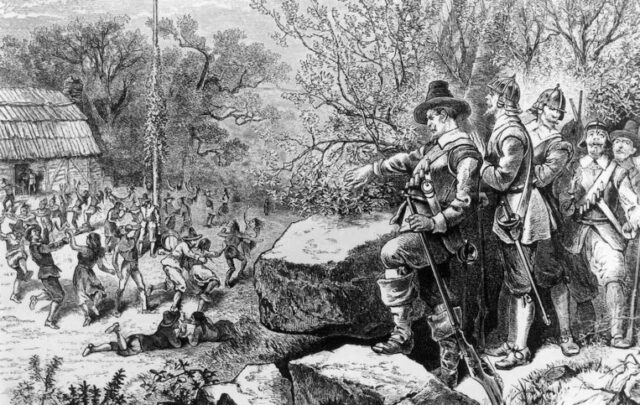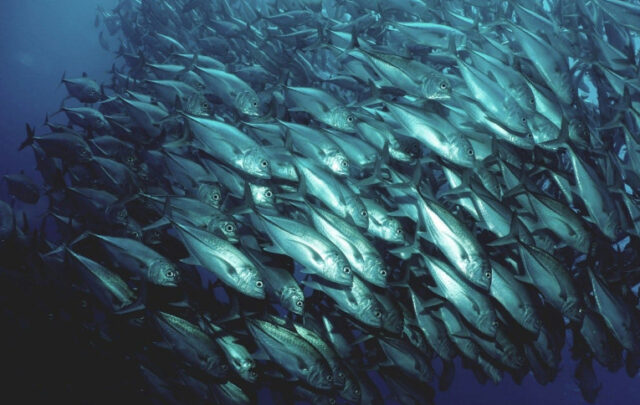
Getting the Message “OVER”: Natural Resource Allocations in an Overpopulated World
December 4, 2015

NOTE: Images in this archived article have been removed.
On Wednesday, November 25th, Andy Revkin, senior fellow for environmental understanding at Pace University, and Dot Earth blogger for the New York Times, decided to use the impending madness of “Black Friday” – the post-Thanksgiving, ad-fueled, cult-of-consumption frenzy — as an opportunity to ask some questions about environmentally themed, exhibit-format books.
He starts out rhetorically wondering “Who thought up the idea of massive books about the world’s wild extremes and, more surreally, about overconsumption itself?” It quickly becomes apparent, however, that the primary object of his scrutiny is Overdevelopment, Overpopulation, Overshoot (hereafter “OVER,” for short) – a large format, coffee-table book (12” X 14” X 1.25”) produced through a partnership between Population Media Center, Population Institute, and the Foundation for Deep Ecology.
OVER also serves as the centerpiece of the international Global Population Speak Out campaign, which explores connections between the size and growth of the human population and key sustainability issues such as carbon emissions and biodiversity conservation.
Considering that one of OVER’s fundamental goals was to spark public dialog and reflection on resource extraction and use (in addition to the human population trajectory), we were glad to see the coverage.
We had originally sent a complimentary copy of OVER to Dot Earth and many other journalists in late April, and in the intervening eight months, there have been more than 250 media reports on the book from 40+ countries around the world, many of them presented as major photo-essays (see examples here, here, and here). The combined circulation of these media outlets is over 1 billion people. Furthermore, as Mr. Revkin noted in his post, OVER covers “themes at the heart of this [Dot Earth] blog — the harms from persistent high fertility rates, consumption for consumption’s sake, disregard for the environmental and social impacts of resource extraction.”
Upon his review, however, Mr. Revkin was taken aback by the book’s dimensions – to use his word, he “recoiled” – because OVER’s mass struck him as clashing so primally with the book’s call to stop overloading the planet with too many people consuming too much stuff. “Stuff like books that weigh almost as much as a Thanksgiving turkey,” to be exact.
Thus we were prompted to consider whether Mr. Revkin was perhaps protesting too much, or offering a legitimate point of criticism? Had the book’s editorial team erred in this whole endeavor? Would we (and the thousands of Speak Out participants around the world) have to walk around ashamedly the rest of the year for our ecological faux pas?
Adding It Up
Including cover, a marketing belly-band, and an individual shipping carton, each copy of OVER weighs about 7 lbs. or 3.1 KG. A print run of approximately 10,000 copies therefore required about 70,000 lbs. (32 metric tons) of book-related paper and cardboard. Note that as recently as 2011, 400 million metric tons (MMT) of paper and cardboard were being produced each year. For those keeping track, 400 million metric tons converts into 882 billion lbs. (881,849,048,740 lbs. to be exact).
This means that the investment in OVER, an educational instrument of social consequence, copies of which should last forever if taken care of (no planned obsolescence here) is equal to just 0.0000079% of the annual global paper and cardboard production, circa 2011. (70,000 / 882,000,000,000)*100 = 0.00000793787%
Another way to think about this is that it would have required the production of 7 billion lbs. of OVER books to equal just 0.79% of the total annual paper and cardboard market. (7,000,000,000 lbs. /882,000,000,000 lbs.)*100 = .79%
Of course, to get 7 billion lbs. of a 7 pound book would have required the production of 1 billion books. Recall that OVER measures 1.25 inches in thickness. Therefore, 1 billion copies of OVER piled on top of each other would create a stack measuring 1.25 billion inches, or 104 million feet. Or 19,728 miles. Yet this even this surreal stack would only amount to less than 1 percent of the total 2011 global paper and cardboard market!
Furthermore, to equal the total paper and cardboard production of 2011, the press run required would have been 126 billion copies of OVER. (882,000,000,000 lbs. / 7lbs per book = 126,000,000,000 books)
Stacking 126 billion copies of OVER books into a single tower would be quite difficult, considering the final height would be about 2.48 million miles. An easier option might be to create 10 separate stacks of 12.1 billion books each – all of which would reach to the moon from the Earth’s surface (and you would still have 4.9 billion copies left-over: enough to hand one to each and every human inhabitant of Africa, Canada, China, Europe, India, Mexico, and the United States).
If nothing else, these figures are an object lesson on how massive global paper and cardboard annual consumption truly is.
As suggested in OVER’s “Lord Man” parable, “natural resources” are generally a euphemism for our neighbors in the community of life. Living trees, for example, become paper pulp. It would be best if every decision about resources was made with reverence and respect. One obvious message in OVER is that, unfortunately, the exact opposite holds true today: many resource extraction and allocation decisions are made with absolute disregard for the community of life. And, given human decisions are now made at a scale of 7.3+ billion, this disregard and disrespect has snowballed to the point where the very integrity of the planet’s ecosystems are either already compromised or severely imperiled.
Given the impact OVER has already made on public awareness and opinion — and especially its adoption by many hundreds of educational institutions, teachers, and other environmental educators as a durable curriculum resource — perhaps critics should consider that it was actually an ethical and extremely modest decision to produce it? Certainly the team who produced the book thought carefully about the resource use its production entailed and decided to make the biggest splash we could about the formula that matters most to the fate of the nature and people: overpopulation + overdevelopment = overshoot.
If nothing else, Dot Earth readers viewing the blog on their phones, tablets, and other devices might want to think about how many rare-earth metals, petroleum-based plastics, and known toxins are necessary for their devices to exist and function. This is not to suggest Dot Earth readers’ individual consumption is condemnable, per se, but to echo Mr. Revkin’s assessment of one of OVER’s messages – that is, to point out there are simply “too many people consuming too much stuff.”
Finally, as to Mr. Revkin’s initial question of “Who thought up the idea of massive books about the world’s wild extremes and, more surreally, about overconsumption itself?” the answer seems most likely to be David Brower and The Sierra Club, who used exhibit-format photo books in the 1960s to help fight proposed dams on the Colorado River, build support for the designation of a Redwood National Park, and facilitate other landmark environmental campaigns.
Surely there is a categorical difference between the consumptive lunacy of Black Friday, where shoppers fist-fight for items like large-screen TVs and video game consoles, and a reusable, educational tome like OVER?
Even if the critics cannot see any difference, the question still reverts to their court: “What would you have had us do instead?” Remain silent? Or, perhaps, hand out a few thousand Kindles?




